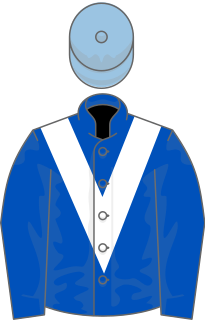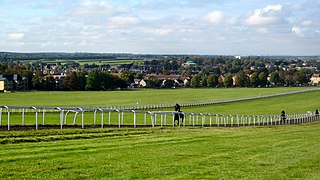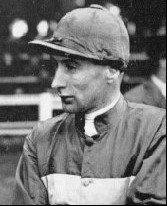Sweet Solera (1958–1978) was an Irish-bred, British-trained Thoroughbred racehorse. In a racing career lasting from June 1960 until June 1961, the unfashionably-bred filly ran eight times and won six races. As a two-year-old she was beaten in her first two races, but her five-lengths win in the Cherry Hinton Stakes at Newmarket Racecourse was enough to see her rated among the best juveniles of the year. Sweet Solera was unbeaten in four races including the 1000 Guineas at Newmarket and Oaks at Epsom. She was then retired to stud, and had some success as a broodmare.
Shadayid was an American-bred, British-trained Thoroughbred racehorse and broodmare. In a racing career which lasted from June 1990 to November 1991 she ran eleven times winning five races and being placed five times. Shadayid was one of the leading two-year-old fillies in Europe in 1990, winning all three of her races including the Group One Prix Marcel Boussac at the Longchamp. After winning the Fred Darling Stakes on her three-year-old debut, Shadayid took her unbeaten run to five by winning the Classic 1000 Guineas at Newmarket. Although she never won again, she finished second in the Coronation Stakes and the Sussex Stakes and third in the Haydock Sprint Cup and the Queen Elizabeth II Stakes. Shadayid was retired from racing to become a broodmare at the end of her three-year-old season after finishing seventh in the Breeders' Cup Mile.

Moonshell was an Irish-bred Thoroughbred racehorse and broodmare best known for winning The Oaks in 1995. In a racing career which lasted from October 1994 to May 1996, the filly ran five times and won two races. After winning her only race as a two-year-old, Moonshell joined the Godolphin Racing team and spent the winter in Dubai. In the spring of 2005, she returned to England to finish third in the 1000 Guineas at Newmarket and then won the Classic Oaks over one and a half miles at Epsom. Moonshell did not run again as a three-year-old and was well beaten in two races in 1996 before being retired to stud.

Rockfel was a British Thoroughbred racehorse and broodmare, best known for winning two Classics in 1938. In a career which lasted from July 1937 until May 1939 she ran thirteen times and won eight races. Rockfel began her career at the lowest level, being beaten in a selling race, but improved to become recognised as one of the best British racemares of the 20th century. In 1938 she was the dominant three-year-old in England, winning the 1000 Guineas over one mile at Newmarket and the Oaks over one and a half miles at Epsom. In the autumn she defeated colts in the Champion Stakes and the Aintree Derby and was retired after winning her only race as a four-year-old. She produced one foal before dying in November 1941.
Herringbone was a British Thoroughbred racehorse and broodmare, best known for winning two Classics in 1943. The filly won four times from ten races in a track career which lasted from spring 1942 until September 1943. As a two-year-old in 1942 she won twice from five starts but was not among the best of her generation. After being beaten on her three-year-old debut she won the 1000 Guineas over one mile at and finished fourth in the Oaks over one and a half miles a month later. In September she beat a field which included the Derby winner Straight Deal to win the St Leger Stakes over one and three quarter miles. All three of the races took place at Newmarket's July Course. After her second classic win she was retired to stud, where she became a successful broodmare.
Fleet, known in the United States as Fleet II, was an Irish-bred, British-trained Thoroughbred racehorse and broodmare who won the classic 1000 Guineas in 1967. In a racing career lasting from June 1966 until July 1967, the filly contested nine races and won five times. As a two-year-old in 1966, Fleet won two of her three races including the Cheveley Park Stakes and was the highest rated filly of her age in Britain. In the following year she won three races over a distance of one mile including the 1000 Guineas and the Coronation Stakes. When tried over longer distances she finished fourth in The Oaks and Eclipse Stakes. She was retired to stud where she had some success as a broodmare in Britain and the United States.
Pourparler was an Irish Thoroughbred racehorse and broodmare who won the classic 1000 Guineas in 1964. In a racing career lasting from the spring of 1963 until July 1964, the filly ran ten times and won three races. As a two-year-old, Pourparler won two important races in England and finished third in the Prix Robert Papin in France. In the following spring, she was beaten in her first two races before winning the 1000 Guineas at Newmarket. She was beaten in her two subsequent races before being retired to stud, where she had limited success as a broodmare.
Waterloo was British Thoroughbred racehorse and broodmare best known for winning the classic 1000 Guineas in 1972. Waterloo was one of the leading British two-year-olds of 1971 when her wins included the Queen Mary Stakes and the Cheveley Park Stakes. In the following year she followed up her victory in the Guineas by winning the Falmouth Stakes. She was later sold and exported to the United States and had some success as a broodmare.
Full Dress was a French-bred, British-trained Thoroughbred racehorse and broodmare best known for winning the classic 1000 Guineas in 1969. Full Dress was beaten on her first two starts as a two-year-old but then won the Crookham Stakes at Newbury Racecourse. In the following spring she won the 1000 Guineas Trial Stakes at Ascot before surviving and objection to win the Guineas. She was beaten in her two subsequent races and was retired to stud where she had some success as a broodmare.
Marwell was an Irish-bred, British-trained Thoroughbred racehorse and broodmare. A specialist sprinter, she won ten of her thirteen races, including several against colts and older horses, and was the highest-rated filly of her generation in Europe at both two and three years of age. She won all five of her races as a two-year-old in 1980, including the Molecomb Stakes, Flying Childers Stakes, and Cheveley Park Stakes. In the following year, she was beaten over a mile in the classic 1000 Guineas but returned to sprinting to win the King's Stand Stakes July Cup and Prix de l'Abbaye. She was retired from racing at the end of 1981 and became a successful broodmare. Marwell died in 2003.
On The House was a French-bred, British-trined Thoroughbred racehorse and broodmare best known for winning the classic 1000 Guineas in 1982. She was one of the best British two-year-old fillies of 1981 when she won two races and finished second in the Cheveley Park Stakes. In the following spring she ran poorly in her first race but then recorded an upset victory in the 169th running of the 1000 Guineas. After being beaten in her next two races she again upset the odds by winning the all-aged Sussex Stakes. After her retirement from racing she had some success as a broodmare and i the female-line ancestor of Cracksman.
One in a Million was an Irish-bred, British-trained Thoroughbred racehorse and broodmare best known for winning the classic 1000 Guineas in 1979. She won both her races as a two-year-old in impressive style and began her three-year-old season with a five length win in the Nell Gwyn Stakes. She won the 1000 Guineas as a short-priced favourite and was awarded victory in the Coronation Stakes on the disqualifiaction of Buz Kashi. She lost her unbeaten record when finishing unplaced in the July Cup and never raced again. After being retired from racing she had considerable success as a broodmare. She died in 1992.
Commotion was a British Thoroughbred racehorse and broodmare who raced during World War II and was best known for winning the classic Oaks Stakes in 1941. After racing over sprint distances, she was stepped up in distance the substitute "New Oaks" over one and a half miles at Newmarket Racecourse. On her next appearance she won the Falmouth Stakes and was then retired from racing. She later became a very successful broodmare.
Desirable was a British thoroughbred racehorse and broodmare. As a two-year-old in 1983 she won on her debut and then took the Princess Margaret Stakes on her second appearance. After finishing second in the Lowther Stakes and the Moyglare Stud Stakes she recorded her biggest victory in the Cheveley Park Stakes. In the following year she failed to win but was placed in the 1000 Guineas and the Nassau Stakes as well as finishing fourth in the Coronation Stakes and the Irish Champion Stakes. After her retirement from racing she became a very successful broodmare, producing the 1000 Guineas winner Shadayid and several other good winners.
Lovely Rosa was an Irish-bred, British-trained Thoroughbred racehorse and broodmare best known for her win in the 1936 Epsom Oaks. As a juvenile in 1945 she showed some promise when finishing second in the Queen Mary Stakes and winning a race at Newbury but then showed little worthwhile form until her 33/1 upset victory in the Oaks. She never won again and was retired at the end of 1936. She had some success as a broodmare, most notably being the grand-dam of Wilwyn.
Campanula was a British Thoroughbred racehorse and broodmare. In 1933 she won two of her five races including the Windsor Castle Stakes and the Moulton Stakes and was rated the best juvenile filly in England. In the following spring she won the Column Produce Stakes and then recorded her biggest win in the 1000 Guineas. In her two subsequent races she finished fourth in the Epsom Oaks and second in the Champion Stakes. As a broodmare she exerted an enduring influence as a broodmare through her daughter Calluna.
Four Course was a British Thoroughbred racehorse. She was one of the best two-year-old fillies of her generation in England when she won three of her four races, namely the July Stakes, Richmond Stakes and Gimcrack Stakes. In the following spring she won the 1000 Guineas and finished second in both the Epsom Oaks and the Falmouth Stakes. She was retired at the end of the year but died before she could make and mark as a broodmare.
Canyon was a British Thoroughbred racehorse and broodmare. As a two-year-old in 1915 she won three races including the Bedford Stakes and the Bretby Stakes as well as finishing second in the Dewhurst Stakes. In the following spring she recorded her biggest win when defeating Fifinella in the 1000 Guineas. Canyon failed to win again but after her retirement from racing she became a very successful broodmare, whose offspring included Colorado and two other major winners.
Hypericum was a British Thoroughbred racehorse and broodmare. Bred and owned by King George VI she was one of the best two-year-old fillies in England in 1945 when she won two of her four races including the Dewhurst Stakes as well as finishing second in the Middle Park Stakes. In the following year she became increasingly temperamental but after finishing second on her seasonal debut she won the 1000 Guineas despite throwing her jockey and bolting before the start. In her two subsequent races she finished fourth in the Epsom Oaks and unplaced in the Coronation Stakes. As a broodmare she had an enduring influence on the breed through her granddaughter Highclere.
Queenpot was a British Thoroughbred racehorse and broodmare. She won three times as a juvenile in 1947, with her biggest success of the year coming in the Prendergast Stakes at Newmarket Racecourse. In the following spring she took the Katheryn Howard Stakes before recording her most significant victory in the 1000 Guineas. As a broodmare she produced several minor winners including the dam of Northjet.













